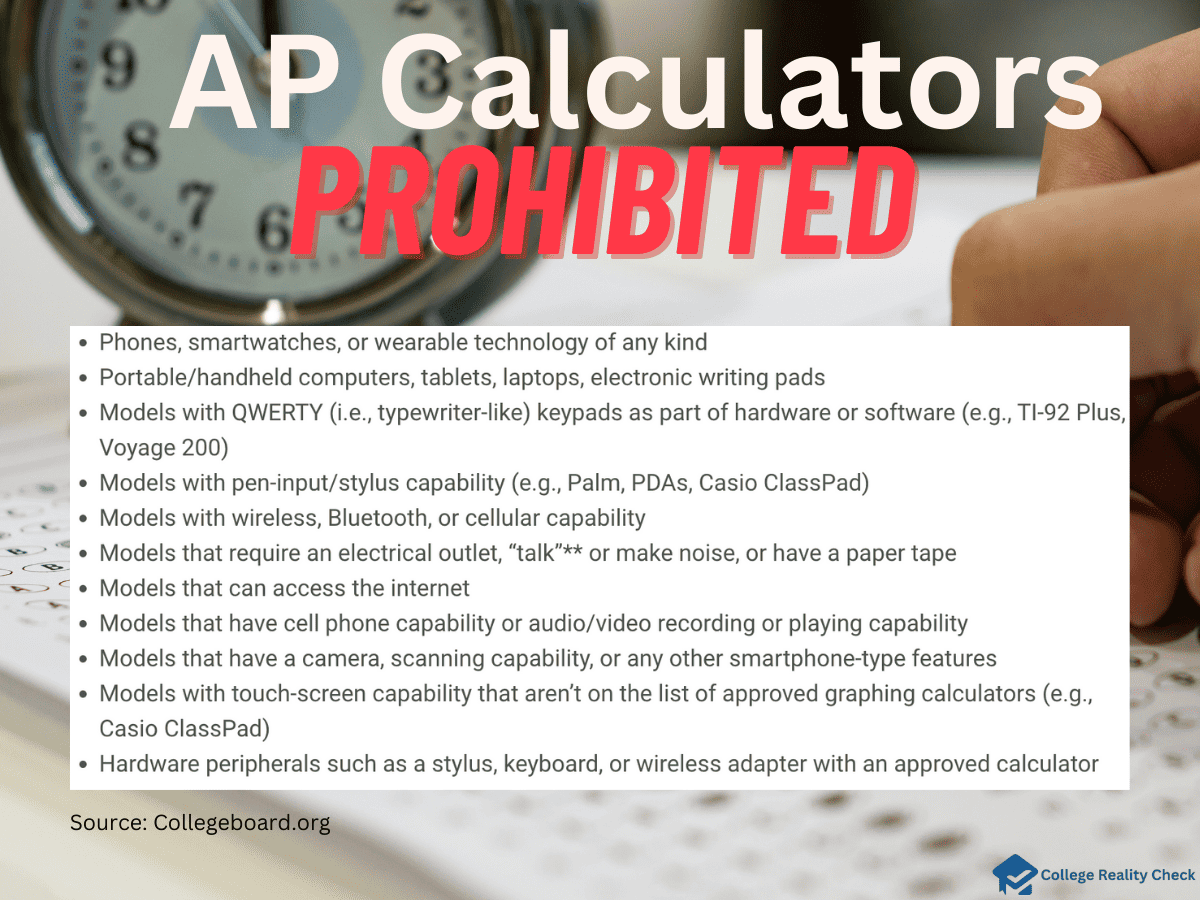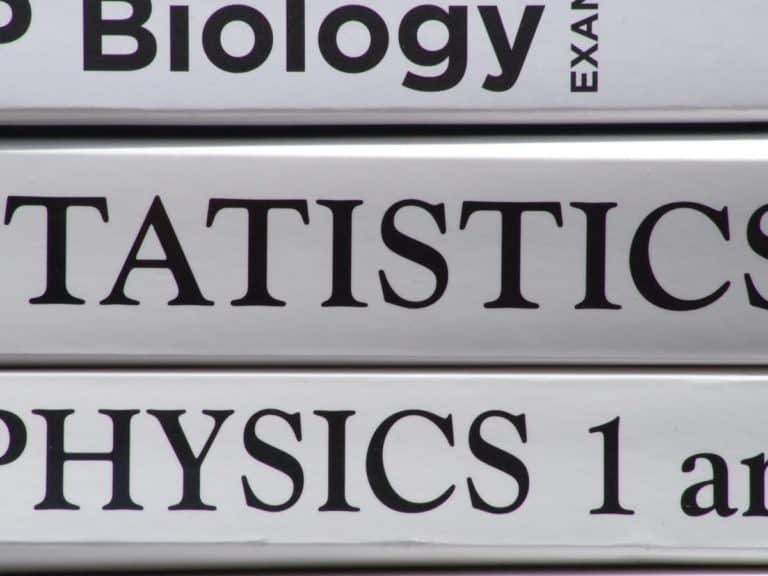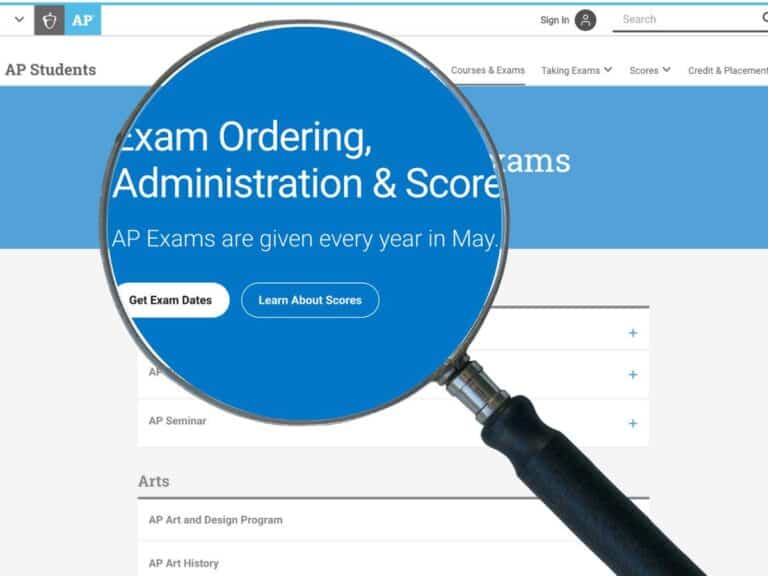AP Exams Unlocked: Your Path to College Credits Revealed
AP courses may help you get into a selective school.
Because AP course grades have weight, they can boost your weighted GPA.
Taking them also increases academic rigor and eligibility for certain scholarships.
AP courses can do all that except win you some college credits.
Sitting for AP exams is what you need to do if you want to earn credit, save money, and graduate faster.
In most instances, colleges award credit for challenging AP tests with a score of at least 3 — aiming for 4 or 5 is better if you are looking to attend a competitive institution.

AP Exams vs. IB Exams: What’s the Difference?
When talking about AP exams, it’s not unlikely for many students to also discuss IB exams.
AP tests are a part of the AP program, administered by the College Board.
Meanwhile, IB exams are a part of the International Baccalaureate program (IB) program, administered by the International Baccalaureate Organization in Geneva, Switzerland.
Reduced Fees for AP Exams and IB Exams
AP exams cost $98 each.
On the other hand, IB exams cost $135 each.
There is no such thing as an AP exam fee waiver, although students from low-income backgrounds who are eligible for an AP exam fee reduction only need to pay $53 per examination.
Fee reductions on IB exams can vary from district to district or from state to state.
In New York, for instance, reduced IB exams cost only $5 each.
38 AP Exams vs. One IB Diploma Exam
Students can choose from 38 AP exams.
Meanwhile, to earn an IB diploma, students have to take only a single test.
However, the test consists of six subject groups, each coming from a different level in terms of difficulty — three are from the standard level (SL) and three from the higher level (HL).
Students may choose to take only certain IB exams, but it will not earn them an IB diploma.
IB Exams Require IB Courses, AP Exams Don’t
Students can sit for AP exams whether or not they took AP courses.
Similarly, high school teens may take the particular AP course of their liking throughout the academic year and then choose to take an AP test for an entirely different AP course.
On the other hand, only those who take IB courses are eligible to take IB exams.
Colleges Award Credit for AP Exams and IB Exams
Many colleges and universities in the United States give credit to AP exams and IB exams.
In most instances, schools award college credit for specific AP exam subjects that meet a minimum score.
Although some postsecondary institutions award college credit for individual IB exams with a passing score, others only give credit to students with a full IB diploma.
So, Should You Take AP Exams or IB Exams?
Both AP exams and IB exams have their own set of advantages and disadvantages.
It’s crucial to consider your examination preferences and academic goals in college when deciding whether AP exams or IB exams are the ones you should register for in high school.
AP Exam Credit Policy
Taking AP exams of your choosing to earn credit in college won’t do — it’s a must that you take AP exams that your top-choice college accepts, often some of the most challenging AP subjects around.
Of course, getting a passing score of 3 is also crucial.
For those who are eyeing selective institutions, unfortunately, they may have to get a 4 or 5.
Therefore, you must check out your dream school’s AP credit policy to determine which AP exams you must take and how high your scores should be to earn credit.
Meeting the Minimum Score to Earn College Credit
As mentioned, there are 38 AP exams to choose from.
However, most institutions of higher education do not give college credit to all of them.
In most instances, they give credit to some of the most challenging AP exams only, which is almost always the case with competitive schools participating in the AP program.
What’s more, they give credit only if students earn the minimum required score.
Numerous AP program participating colleges require a minimum score of 3, although you can expect selective ones to require AP exam scores of 4 or 5 for credit.
The University of Pennsylvania, for instance, accepts only AP exam scores of 5 and nothing else!
Meanwhile, Princeton University, another Ivy League like UPenn, is more forgiving.
Here are the AP exams and their minimum scores that Princeton awards college credits to:
| AP Exam | Minimum Score | Number of Credits |
|---|---|---|
| AP Biology | 5 | 2 |
| AP Calculus AB | 5 | 1 |
| AP Calculus BC | 5 | 4 |
| AP Chemistry | 4 | 1 |
| AP Chemistry | 5 | 1 |
| AP English Literature and Composition | 5 | 1 |
| AP European History | 4 | 1 |
| AP French Language and Culture | 5 | 2 |
| AP German Language and Culture | 5 | 2 |
| AP Italian Language and Culture | 5 | 2 |
| AP Latin | 5 | 2 |
| AP Macroeconomics | 5 | 1 |
| AP Microeconomics | 5 | 1 |
| AP Physics 1 | 5 | 2 |
| AP Physics 2 | 5 | 2 |
| AP Physics C: Electricity and Magnetism | 5 | 2 |
| AP Physics C: Mechanics | 4 | 2 |
| AP Physics C: Mechanics | 5 | 2 |
| AP Spanish Language and Culture | 5 | 2 |
| AP United States History | 4 | 1 |
| AP World History: Modern | 4 | 1 |
AP Exams for Advanced College Placement
Some colleges participating in the AP program may not award credit for AP exams.
Instead, they offer placement into advanced courses.
Brown University is one example of those institutions that offer advanced course placement for students with AP exam scores but do not allow them to earn any college credit.
Here are the AP exams and scores you need to take advanced courses at Brown:
| AP Exam | Minimum Score | Equivalent Course |
|---|---|---|
| AP Biology | 4 | BIOL 0200 |
| AP Calculus AB | 4 | MATH 0090 |
| AP Calculus BC | 3 | MATH 0090 |
| AP Calculus BC | 4 | MATH 0090 and MATH 0100 |
| AP Environmental Science | 5 | ENVS 0490 |
| AP French Language and Culture | 5 | FREN 0500 |
| AP French Language and Culture | 4 | FREN 0400 |
| AP German Language and Culture | 4 | GRMN 0400 |
| AP Italian Language and Culture | 4 | ITAL 0300 |
| AP Italian Language and Culture | 5 | ITAL 0400 |
| AP Macroeconomics | 4 | Economics 0110 |
| AP Microeconomics | 4 | Economics 0110 |
Many colleges accept numerous AP exams for credit.
Purdue University – West Lafayette, for example, accepts nearly 40 AP exams for advanced placement purposes — you only need to get a score of 3 for many of them for advanced courses.
Many AP exams Purdue accepts can also place you into multiple advanced courses.
For instance, here are the equivalent courses for the AP German Language and Culture Exam with a score of 5:
- GER 10100
- GER 10200
- GER 20100
- GER 20200
What It’s Like to Take AP Exams
According to the US Department of Education, high test anxiety is prevalent in 15% to 22% of students.
Of course, it may cause you to get a low score.
Knowing what an AP exam is like can help relieve some of your anxiety, and it also allows you to formulate the appropriate testing strategy so that you can sit for the AP exam with more ease and confidence.
Two Main Sections and Occasional Subsections
AP exams are standardized tests because all test-takers must answer the same set of questions.
The grading of their AP exams is the same, too.
Like other standardized examinations such as the SAT and ACT, AP tests come in different sections.
Most AP exams come in two sections — it’s not unlikely for a main section to comprise two subsections.
The AP French Language and Culture Exam, for instance, has multiple subsections:
- Section 1A
- Section 1B
- Section 2A
- Section 2B
Types of Questions to Answer
AP exams have two question formats:
- Multiple-choice questions
- Free-response questions
In most instances, the first section of an AP examination consists of multiple-choice questions — some questions have four answer options, while others have as many as five answer options.
The second section of many AP exams consists of free-response questions.
Of course, you will find free-response questions in AP exams with writing components.
How Long are AP Exams?
AP exams take one to three hours long.
But it’s worth pointing out that most AP exams are closer to three hours.
It’s also important to remember that some are longer than three hours!
How long you must sit for an AP exam depends on the number of questions to answer and the difficulty level of the subject — typically, the more challenging the AP exam, the longer the exam time.
Here are some AP exams and their duration:
| AP Exam | Duration |
|---|---|
| AP Art History | 3 hours |
| AP Biology | 3 hours |
| AP Calculus AB | 3 hours and 15 minutes |
| AP Calculus BC | 3 hours and 15 minutes |
| AP Chemistry | 3 hours and 15 minutes |
| AP Computer Science A | 3 hours |
| AP English Language and Composition | 3 hours and 15 minutes |
| AP English Literature and Composition | 3 hours |
| AP Environmental Science | 2 hours and 40 minutes |
| AP European History | 3 hours and 15 minutes |
| AP Human Geography | 2 hours and 15 minutes |
| AP Latin | 3 hours |
| AP Macroeconomics | 2 hours and 10 minutes |
| AP Physics 1 | 3 hours |
| AP Physics 2 | 3 hours |
| AP Psychology | 2 hours |
| AP Spanish Language and Culture | 3 hours and 3 minutes |
| AP Spanish Literature and Culture | 3 hours |
| AP Statistics | 3 hours |
| AP United States History | 3 hours and 15 minutes |
| AP World History: Modern | 3 hours and 15 minutes |
Bring Your Own Calculator
Fact: you can answer math questions on the AP exam without a calculator.
You must hand copy, date, and sign the Calculator Release Statement on the test day, which your AP coordinator or proctor will provide before the test begins.
However, that would be unwise because, like other tests, AP exams are timed examinations.
Ensure you put a calculator in your bag before heading to the testing location — your designated test center won’t provide you with one.
Be warned: not all devices that can calculate are permissible!
Click on this link to check out the updated list of calculator models the College Board allows.

Are AP Exams Computerized?
According to the College Board, it’s up to high schools to choose between paper and digital AP exams.
They may also choose a combination of paper and digital tests.
It’s not too long ago when digital AP exams became available.
Not all AP exams are available in digital format.
Here are AP exam subjects that you may take digitally:
- AP Computer Science Principles
- AP English Language and Composition
- AP English Literature and Composition
- AP European History
- AP Seminar
- AP U.S. History
- AP World History: Modern
- AP African American Studies
Digital AP exams are the same as paper AP exams in terms of administration date, number of questions, number of sections, and content — the only difference is that you take them using a computer.
Can I Guess on the AP Exam?
There is no penalty for wrong answers on the AP Exam.
Because of this, you should consider guessing if you absolutely don’t know the answer to a question — you get one correct score if you guessed correctly and no unfavorable consequence if you guessed incorrectly.
However, there is a right way to guess on your AP exam, and it’s not randomly picking an answer.
What you need to do is eliminate answer options you believe are wrong.
The more wrong answers you eliminate, the higher your chances of getting the correct answer.
Eliminating one incorrect answer from the five answer options, for instance, increases your chances of answering the question correctly from 20% to 25%.
Eliminating three incorrect ones increases your chances to 50%!
What is a Good AP Exam Score?
A good AP exam score is a 3, which also happens to be the passing score.
It’s also the score you should aim for if you are looking to earn college credit.
Are you planning on attending a competitive school?
Then aim for a 4 or 5 AP exam score to earn course credit — go for a score of 5 if the college is highly selective (or check its AP credit policy by using this tool by the College Board).
You may also compare your AP exam score with the average score for your test year.
As an example, the average AP exam score was 2.96.
How Many Times Can I Retake the AP Exam?
You can retake the AP exam each administration date: once a year in May.
There is no limit as to how many times you can take AP exams throughout your high school career.
Are you unhappy with your score and believe you can do better?
Consider retaking the same AP exam the following year — you may choose to withhold or cancel your lower score after getting the result of your subsequent test.
AP Practice Tests
Before you go, give the following sample AP exam questions a try.
It’s a great idea to take practice tests to determine whether or not AP exams are suitable for the kind of learner and test taker you are — I would suggest taking sample IB exam questions, too, afterward.
AP English Literature
Now to the ascent of that steep savage hill Satan had journeyed on, pensive and slow; But further way found none; so thick entwined, As one continued brake, the undergrowth Of shrubs and tangling bushes had perplexed (line 5) All path of man or beast that passed that way. One gate there only was, and that looked east On the other side. Which when the Arch-Felon saw, Due entrance he disdained, and, in contempt, At one slight bound high overleaped all bound (line 10) Of hill or highest wall, and sheer within Lights on his feet. As when a prowling wolf, Whom hunger drives to seek new haunt for prey, Watching where shepherds pen their flocks at eve, In hurdled cotes amid the field secure, (line 15) Leaps o’er the fence with ease into the fold; Or as a thief, bent to unhoard the cash Of some rich burgher, whose substantial doors, Cross-barred and bolted fast, fear no assault, In at the window climbs, or o’er the tiles; (line 20) So climb this first grand Thief into God’s fold: So since into his Church lewd hirelings climb.
1. Satan’s action is best described as:
2. In line 5, “perplexed” is best interpreted to mean:
3. In which of the lines does an epic smile begin?
4. Which of the lines contains a play on words?
5. In line 15, “hurdled cotes” refers to:
Answer key:
AP Precalculus
1. The function f is given by f(x) = + 2sin(4x) + cos(2x). Using the period of f, which of the following is the number of complete cycles of the graph of f in the xy-plane on the interval 0 ≤ x ≤ 1000?
2. In a certain simulation, the population of a bacteria colony can be modeled using a geometric sequence, where the first day of the simulation is day 1. The population on day 4 was 4,000 bacteria, and the population on day 8 was 49,000 bacteria. What was the population of the colony on day 6 based on the simulation?
3. The polynomial function p is given by p(x) = (x + 3) (x2 – 2x – 15). Which of the following describes the zeros of p?
4. Fully expand the expression: (x + 4)2
5. Let f be a rational function that is graphed in the xy-plane. Consider x = 1 and x = 7. The polynomial in the numerator of f has a zero at x = 1 and does not have a zero at x = 7. The polynomial in the denominator of f has zeros at both x = 1 and x = 7. The multiplicities of the zeros at x = 1 in the numerator and in the denominator are equal. Which of the following statements is true?
Answer key:
The sample questions above are from the following sites:
https://secure-media.collegeboard.org/
https://www.varsitytutors.com/
Read Next: What is IB?
Disclaimer: The views and opinions expressed in this article are those of the authors and do not necessarily represent those of the College Reality Check.






